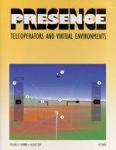Apr 04, 2005
New article about Presence published on Nature!
Maria V. Sanchez-Vives and Mel Slater have published a review article entitled "From Presence to Consciousness through Virtual Reality" on the prestigious journal Nature Neuroscience (ASI impact factor 2003: 27.007).

In this article, the authors argue that presence - the sense of "being there" perceived during the exploration of a virtual environment - is worthy of study by neuroscientists, and that it might aid the study of perception and consciousness.
Maria V. Sanchez-Vives, Mel Slater, From Presence to Consciousness through Virtual Reality, Nature Reviews Neuroscience 6, 332-339 (2005); doi:10.1038/nrn1651
12:15 Posted in Telepresence & virtual presence | Permalink | Comments (0) | Tags: Positive Technology, Presence
Dec 29, 2004
Charles Tart: Virtual Reality & Altered States of Consciousness
The link between VR and altered states of consciousness is an interesting one. One of the first researchers that have discussed this relationship is Charles Tart. According to Tart, VR can be considered a new technological model of consciousness. In particular, he suggests that "stable patterns, stabilized systems of these internal virtual realities, constitute states of consciousness, our ordinary personality, and multiple personalities"
Of particular interest is Tart's explanation of the feeling of being "present" in a computer-generated world, although in its article he doesn't use the word presence. He suggests that presence emerges from a core psychological pattern which "automatically organizes the rest of experience around itself in a way that further supports the basic pattern". He thinks that this is the same process of perceiving a constellation. A constallation is not "real", because the spatial distribution of visible stars is random. However, once a pattern has organized, it is hard not to perceive it that way.
If you want to read more about Tart's theory of virtual reality, read these online articles:
Multiple Personality, Altered States and Virtual Reality: The World Simulation Process Approach
(This is the published version of the paper, which appeared as "Multiple Personality, Altered States and Virtual Reality: The World Simulation Process Approach" in the journal, "Dissociation," Vol. 3, 222-233)
Mind Embodied! Computer-Generated Virtual Reality as a New, Dualistic-Interactive Model for Transpersonal Psychology
(Based on a speech given at the L. E. Rhine Centenary Conference on Cultivating Consciousness for Enhancing Human Potential, Wellness and Healing, Durham, North Carolina, November 9, 1991. A modified version was later published in K. Rao (Editor), "Cultivating Consciousness: Enhancing Human Potential, Wellness and Healing." Westport, Connecticut: Praeger, 1993. Pp. 123-137.)
02:15 Posted in Telepresence & virtual presence | Permalink | Comments (0) | Tags: Positive Technology, Presence
Dec 23, 2004
Presence 13:5 Now Available
The first journal for serious investigators of teleoperators and virtual environments, incorporating perspectives from physics to philosophy.  Vol. 13, Issue 5 - October 2004 Articles Article available as PDFSAMPLE ARTICLE - FREELY AVAILABLE!The Role of Graphical Feedback About Self-Movement when Receiving Objects in an Augmented Environment Andrea H. Mason and Christine L. MacKenzie Haptic Interfaces for Wheelchair Navigation in the Built Environment Colin S. Harrison, Mike Grant and Bernard A. Conway Exploring the Roles of Information in the Manual Control of Vehicular Locomotion: From Kinematics and Dynamics to Cybernetics Max Mulder, René van Paassen and Erwin Boer The Importance of Stereo and Eye Coupled Perspective for Eye-Hand Coordination in Fish Tank VR Roland Arsenault and Colin Ware Does the Quality of the Computer Graphics Matter when Judging Distances in Visually Immersive Environments? William B. Thompson, Peter Willemsen, Amy A. Gooch, Sarah H. Creem-Regehr, Jack M. Loomis and Andrew C. Beall Limited Field of View of Head-Mounted Displays Is Not the Cause of Distance Underestimation in Virtual Environments Joshua M. Knapp and Jack M. Loomis An Independent Visual Background Reduced Simulator Sickness in a Driving Simulator Henry Been-Lirn Duh, Donald E. Parker and Thomas A. Furness Toward Systematic Control of Cybersickness Marshall B. Jones, Robert S. Kennedy and Kay M. Stanney Postural Responses to Two Technologies for Generating Optical Flow Thomas A. Stoffregen, Benoît G. Bardy, Omar A. Merhi and Olivier Oullier [ More on Vol. 13, Issue 5 - October 2004 | Presence: Teleoperators and Virtual Environments Home Page | Presence: Teleoperators and Virtual Environments Orders and Renewals ]
Vol. 13, Issue 5 - October 2004 Articles Article available as PDFSAMPLE ARTICLE - FREELY AVAILABLE!The Role of Graphical Feedback About Self-Movement when Receiving Objects in an Augmented Environment Andrea H. Mason and Christine L. MacKenzie Haptic Interfaces for Wheelchair Navigation in the Built Environment Colin S. Harrison, Mike Grant and Bernard A. Conway Exploring the Roles of Information in the Manual Control of Vehicular Locomotion: From Kinematics and Dynamics to Cybernetics Max Mulder, René van Paassen and Erwin Boer The Importance of Stereo and Eye Coupled Perspective for Eye-Hand Coordination in Fish Tank VR Roland Arsenault and Colin Ware Does the Quality of the Computer Graphics Matter when Judging Distances in Visually Immersive Environments? William B. Thompson, Peter Willemsen, Amy A. Gooch, Sarah H. Creem-Regehr, Jack M. Loomis and Andrew C. Beall Limited Field of View of Head-Mounted Displays Is Not the Cause of Distance Underestimation in Virtual Environments Joshua M. Knapp and Jack M. Loomis An Independent Visual Background Reduced Simulator Sickness in a Driving Simulator Henry Been-Lirn Duh, Donald E. Parker and Thomas A. Furness Toward Systematic Control of Cybersickness Marshall B. Jones, Robert S. Kennedy and Kay M. Stanney Postural Responses to Two Technologies for Generating Optical Flow Thomas A. Stoffregen, Benoît G. Bardy, Omar A. Merhi and Olivier Oullier [ More on Vol. 13, Issue 5 - October 2004 | Presence: Teleoperators and Virtual Environments Home Page | Presence: Teleoperators and Virtual Environments Orders and Renewals ]
01:05 Posted in Telepresence & virtual presence | Permalink | Comments (0) | Tags: Positive Technology, Presence







